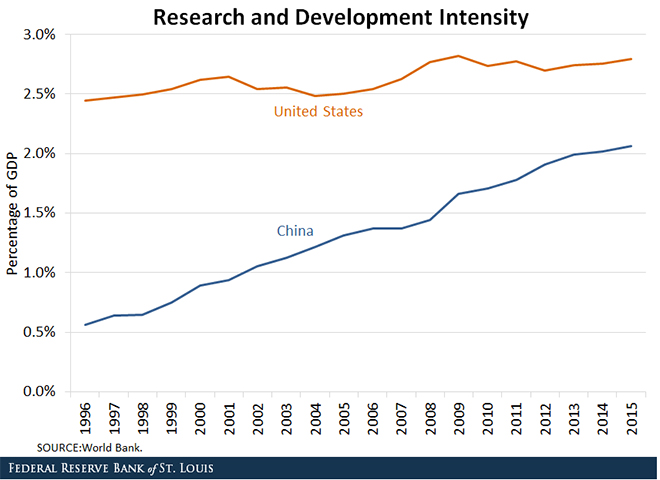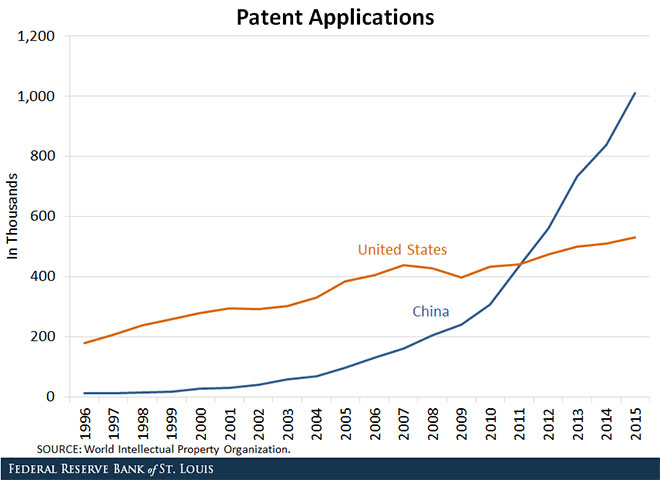by Ana Maria Santacreu and Heting Zhu
Two measures of innovative activity of a country are: Its research and development (R&D) intensity (that is, the fraction of total output invested in R&D), which reflects the effort of innovation Its number of patent applications, which reflects the output of innovation Larger R&D investment is associated with faster technological progress, higher productivity and faster output growth. One of the outcomes of the R&D process is an increase in the number of patent applications.1 Indeed, there tends to be a positive correlation between the R&D intensity of a country and the number of patent applications in that country.
In terms of R&D intensity, the U.S. has been a global leader in innovation for the past 20 years. However, China has been catching up fast in recent years.
In 1996, China invested 0.56 percent of its GDP in R&D, while the U.S. invested 2.44 percent of its GDP. In 2015, China invested 2.06 percent of its GDP, whereas the U.S. invested 2.79 percent. That is, the R&D intensity in China increased by 1.5 percentage points and in the U.S. by only 0.3 percentage points.

Patent Applications: China vs. the U.S.
Regarding patent applications, the U.S. applied for 177,967 patents in 1996, which contrasts with the 11,974 patent applications in China that year. However, in 2015, China exceeded the U.S. in the total number of patent applications by 90 percent, as seen below.

The dominating role that the U.S. has had with respect to patent applications has been challenged in recent years. Is China becoming the new global leader in innovation?2
Why Has China’s Innovation Increased?
There may be several reasons why China is innovating so much more than before. For instance, technological developments in China together with a growing market may favor investment in innovation.
Moreover, the government has been very active at implementing policies to incentivize innovation in China. In 2006, the Chinese government announced the National Indigenous Innovation Campaign, which includes a goal to transform China into the world’s technology powerhouse by 2020.3
In addition, the 12th and 13th “five-year" plans (2011-2020) detailed goals for R&D intensity and patent applications.4 The government offered subsidies targeted to increase the number of patent applications. This could explain why patent applications have grown way faster than R&D intensity.
A Deeper Look at China’s Innovation Path Needed
In conclusion, in terms of R&D intensity, China is approaching the U.S. but still remains behind. In terms of patent applications, however, China has overtaken the U.S. and appears to be the new global leader of innovation.
A big part of this increase, though, may be driven by government subsidies in China. One should control for the quality of the patents to determine whether China is indeed the new global leader in innovation based on the number of patents.
Some studies argue that the quality of Chinese patents are incomparable to their quantity, and these patents are also highly concentrated in certain sectors, such as eletronics.5
If China wants to become the world’s technology powerhouse, more R&D investments targeted to a wider range of industries are needed.
Notes and References:
1 A patent gives the owner a monopoly right to use this new invention for a limited period, generally 20 years.
2 Santacreu, Ana Maria. “The New World Leader in Innovation." Federal Reserve Bank of St. Louis On the Economy Blog, July 3, 2017.
3 McGregor, James. “China's Drive for 'Indigenous Innovation:’ A Web of Industrial Policies." United States Chamber of Commerce. July 28, 2010.
4 Koleski, Katherine. “The 13th Five-Year Plan." U.S. - China Economic and Security Review Commission, Feb. 14, 2017.
5 "Are patents indicative of Chinese innovation?" China Power. Feb. 15, 2016.
No comments:
Post a Comment